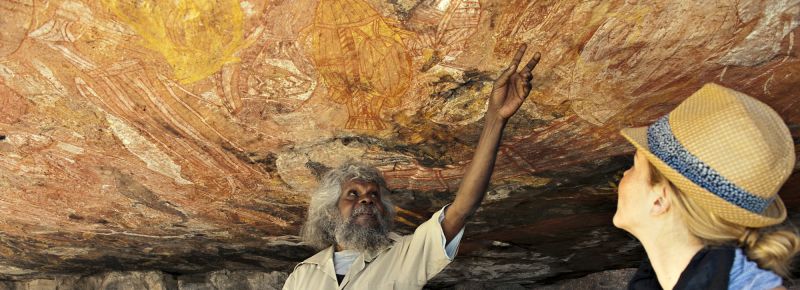Wetlands
Nutrient rich soils are transported into the floodplains via torrents of water falling from the Arnhem Land plateaus during the wet season (typically November to March) providing habitat for Magpie Geese, Whistling Ducks, Great Egrets, Royal Spoonbills, Black-winged Stilts. The combination of warm sunny days and the nutrients provide the perfect conditions for the flora and fauna to flourish including the most famous resident, the Saltwater Crocodile. Along these vast floodplains, it is common to see Paperbark (Malaleuca) forests that provide habitat for Agile Wallabies and nesting sites for birds such as the Black-necked Stork (Jabiru). The wetlands here are of international importance under the Ramsar Convention due to it forming the East Asian-Australia Asian flyway to protect areas used by large numbers of migratory shorebirds. One of the highlights for visitors is to see the beautiful range of water lilies, including the blue, yellow and white snowflake, often supporting the massive toes of the Comb-crested Jacana bird.

Savanna Woodlands
The large majority of Kakadu National Park (over 70%) is classified as the lowlands or savanna woodlands. This landscape is characterised by eucalypt woodlands, spear grasses, sedges and wildflowers growing in shallow soils atop of sheets of laterite (ironstone). This grass seeds and flowering eucalypts support many birds including the many species of Honeyeater, Blue-winged Kookaburra, Red-winged Parrots, Double-barred, Star, Crimson and Long-tailed Finches, Red-collared Lorikeets and Red-tailed Black Cockatoos. It is also the ideal habitat for the Agile Wallaby, Antilopine Wallaroo and Dingoes. Sand (Gould’s) and Yellow-spotted Goannas are seen meandering across the savanna woodlands searching for reptile and bird eggs, invertebrates, lizards and birds. These lizards nest in the incredible giant termite mounds, that are built up to six metres high, made of mud and termite saliva.

Stone Country & Escarpments
Large towering sandstone escarpments up to 300 metres high, form a natural border between Kakadu & Arnhem Land that extends 500km. Approximately 140 million years ago, Kakadu was under a shallow sea and these escarpments were sea cliffs. These escarpments provide breathtaking views over the lush floodplains and woodlands and also drive water into deep gorges that result in tall monsoon rainforests. The stone country of the Arnhem Land plateau was laid down 1650 million years ago and today provide habitat for species such as the Chestnut-quilled Rock Pigeon, Short-eared Rock Wallaby, Black Wallaroo, Leichhardt's Grasshopper, Ghost bat and Merten's Water Monitor. Arnhem Land was created as an Aboriginal Reserve in 1931 with the intention that the Aboriginal people have an opportunity to continue their traditional lifestyle as they have for thousands of years before. Kakadu & Arnhem Land rock art demonstrates their spiritual beliefs and traditions and is also a fascinating insight into their food enjoyed by the nomadic people.

Southern Hills and Ridges
The rocks and ridges found in the south of Kakadu National Park were formed over 2500 million years ago as a result of volcanic activity. These picturesque ridges divide the woodland areas, with the regions pristine waterfalls and plunge pools a favourite for park visitors. It is common to see the Antilopine Wallaroo and Black-breasted Buzzard, with the Gouldian Finch and Hooded Parrot an occasional sighting. There are many unique plants in the area including the beautifully coloured Salmon Gum, Freshwater Mangrove, Silver-leafed Paperback and Yellow Bladderwort orchid.

